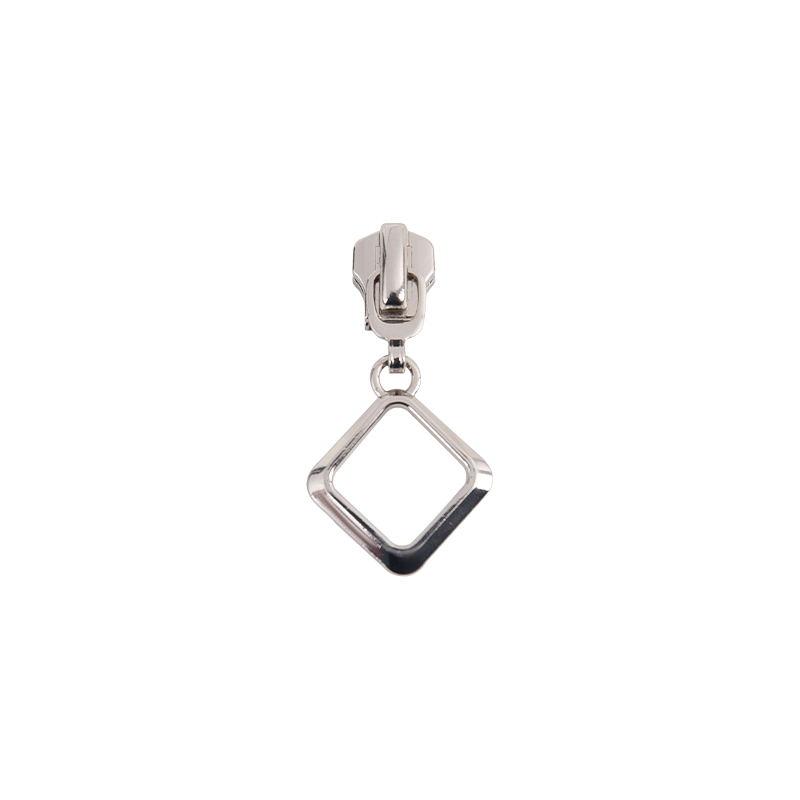To optimize the design of the metal zipper slider to improve its smoothness of opening and closing, we can start from multiple aspects to ensure the comprehensive improvement of the slider's design, materials, process and user experience. The following are some key elements of optimized design:
1. Optimize the shape and structure of the slider
The contour design of the slider: The shape of the slider should be precisely designed according to the tooth shape and structure of the zipper. By adjusting the width, length and curve shape of the slider, the contact friction with the zipper teeth can be reduced and the sliding smoothness can be improved.
Simplification of the slider structure: Adopt a simpler structural design to avoid too many complex parts. The simplified design can reduce friction, increase bearing capacity and reduce jamming.
Design of the slider base: The design of the slider bottom should avoid too many sharp edges and corners. The friction with the zipper tape can be reduced by rounded corner design or appropriate chamfering to ensure smoother sliding.
2. Choose the right metal material
Material selection: Use metal materials with good sliding performance, such as high-quality stainless steel, aluminum alloy or brass alloy. The hardness, toughness and friction coefficient of different materials affect the smoothness of the slider. Stainless steel is often used to improve strength and corrosion resistance, while aluminum alloy is suitable for reducing weight.
Surface treatment: Use surface coating or electroplating (such as nickel plating, chrome plating, etc.) to reduce metal-to-metal friction and reduce wear. Smooth surfaces also help to improve the smoothness of opening and closing.
3. Accurately control the fit between the slider and the zipper teeth
Precision machining: During the production process, ensure the fit accuracy between the metal slider and the zipper teeth. The internal notch of the slider and the zipper teeth should be precisely matched to avoid looseness or jamming. Precision machining can improve the meshing degree between the slider and the zipper teeth and reduce friction.
Tooth shape and gap design: Ensure that the tooth shape design meets the fit requirements of the slider. Tooth shape that is too large or too small may affect the smoothness of the slider, so ensure that the contact angle between the tooth shape and the slider is moderate and the gap is reasonable.
4. Increase lubricity design
Internal lubrication: Applying a suitable lubricant to the internal structure of the slider or the contact surface with the zipper teeth can significantly reduce friction and improve sliding smoothness. Common lubricants include paraffin, silicone oil or other lubricating materials that are not easy to oxidize.
Lubricant coating technology: Use a precise coating process to ensure that the lubricant is evenly covered on the surface of the slider, avoid lubricant accumulation or uneven distribution, and maintain the smooth operation of the slider.
5. Optimize the internal spring system of the slider
Spring design: The spring inside the slider controls the opening and closing force of the zipper. By optimizing the strength and elasticity of the spring, it can be ensured that the zipper is smoother when opening and closing. The appropriate spring force can ensure that the slider has sufficient thrust during movement without causing jamming or excessive pressure.
Spring material and structure: Choose high-quality spring materials, such as stainless steel springs or high-strength alloy materials, to ensure the reliability and stability of the spring in long-term use.
6. Optimize the anti-vibration design of the slider
Shock-absorbing design: When designing the slider, a shock-absorbing structure can be added, especially for zippers that need to be used in extreme environments, such as outdoor equipment or industrial equipment. By using buffer materials or designing appropriate anti-seismic structures, the vibration of the zipper during opening and closing can be reduced, and the stability of operation can be improved.
Structural reinforcement: Through reasonable structural design, the connection between the slider and the zipper tape and zipper teeth is strengthened to avoid deformation or loosening during high-intensity pulling, thereby maintaining a smooth operating feel.
7. Zipper slider weight optimization
Lightweight design: By using lightweight metal materials (such as aluminum alloy) or precision design to reduce the weight of the slider, it can be opened and closed more smoothly. Reducing the weight of the slider can not only reduce the burden during operation, but also reduce the pulling force of the zipper to a certain extent, improving the user's comfort.
Reasonable counterweight design: Although lightweighting helps smooth sliding, the weight of the slider still needs to be maintained to a certain extent to ensure the stability of the zipper during operation and the sense of balance when pulling. Therefore, a suitable counterweight design is essential for smooth opening and closing.
8. Design to reduce the risk of jamming
Surface smoothness of teeth and slider: Ensure that the contact surface between the slider and the zipper teeth is smooth, reduce roughness, and improve the mutual sliding performance of the slider and the teeth. The surface of the slider and zipper teeth can be made smoother through surface polishing, grinding and other processes to reduce the risk of jamming.
Prevent contaminants from entering: When designing the slider, dust, dirt or other contaminants should be prevented from entering the contact surface between the slider and the zipper teeth. This can be done through sealing design or surface treatment to prevent foreign matter from affecting the operating performance of the slider.
By considering these factors, the smoothness of zipper operation can be improved and its service life can be extended.

 en
en  русский
русский 한국어
한국어 get a free quote
get a free quote
















